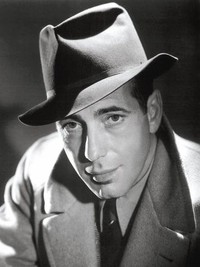Humphrey Bogart

The very definition of the term "film icon," Humphrey Bogart rose from a bit player on Broadway, to a supporting B-movie actor, to eventually become the undisputed reigning box-office star of his day. After making his transition from the stages of New York to the studios of Hollywood with the crime drama "The Petrified Forest" (1936), Bogart endured an extended period playing second banana to more established stars, such as Edward G. Robinson in films like "Bullets or Ballots" (1936). Although productions like "They Drive by Night" (1940) and "High Sierra" (1941) gradually increased his Hollywood standing, it was Bogart's turn as private eye Sam Spade in "The Maltese Falcon" (1941) that first gave audiences a taste of the world-weary cynical, yet moralistic hero he would become so closely associated with. The persona was further cemented with his performances in "Casablanca" (1942) and "The Big Sleep" (1946), with the former hailed by many as one of the greatest films ever made. In between these cinematic milestones he met his co-star and future wife, actress Lauren Bacall, with whom he would appear in a total of four hit films. Other important films in Bogart's remarkable career included "The Treasure of the Sierra Madre" (1948), "Key Largo" (1948), "The African Queen" (1951) - for which he would win his only Academy Award - and "The Caine Mutiny" (1954). Brought down by cancer while still at the height of his creative powers, Bogart would be remembered as an unrepentant iconoclast, irrepressible rabble rouser, and a true American cultural treasure.